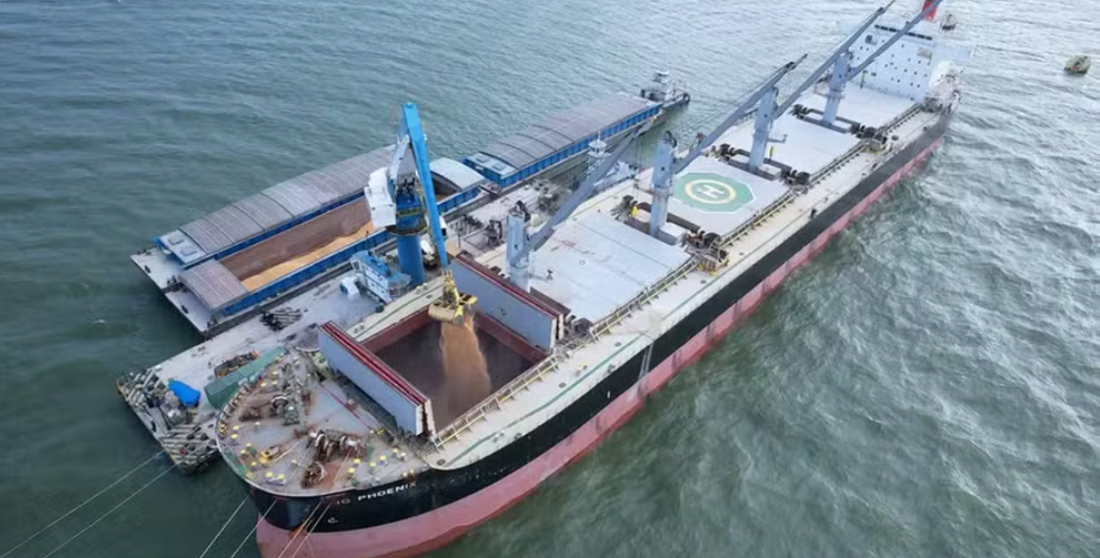
Floating transshipment stations boost grain logistics in northern Brazil
Jan, 26, 2024 Posted by Gabriel MalheirosWeek 202404
Amidst the surge in grain exports through Brazil’s so-called Northern Arc ports, a new transshipment operation model is adding increased capacity to Amazonian terminals. Floating transshipment stations, cheaper, more versatile, and quicker to build than traditional land-based stations, have become pivotal in this growth.
Initially used in wartime to facilitate cargo transfer between vessels without needing to berth at ports, this technology caught the attention of Mega Logística’s President, Eduardo Carvalho, 24 years ago during a trip to the United States.
“I then saw them unloading and loading a scrap metal carrier and thought: if they can do it with scrap metal, they can do it with anything,” recalled the executive. It took seven years to build the first model, initially for a small iron ore operation.
“From that point onwards, we started working on a project with a more robust operational capacity to load Panamax ships and address the ports’ issues, which were on the brink of overcapacity,” Carvalho explained.
With the drop in iron ore prices from 2014 and the growth of grain transportation infrastructure through Brazil’s Northern Arc, the company partnered with two agricultural commodities exporters interested in an entirely river-based operation.
Currently, the company operates three floating Cargo Transshipment Stations (CTS) in the Northern Arc out of four in the region. In 2023, Mega moved 3 million tonnes of solid vegetable bulk and plans to reach 5 million this year.
According to Carvalho, the floating station provides logistical flexibility as it needs only another crane to double operational capacity or another buoy to expand the size to accommodate twice as many ships. Moreover, the structure’s cost is lower: 10% of what is needed to install a land-based station, which can reach R$1 billion. “And I didn’t have R$1 billion to invest in the business then.”
In the view of the President of the Association of Port Terminals and Cargo Transshipment Stations of the Amazon Basin (Amport), Flávio Acatauassú, the new structure has been crucial to ensuring the expansion of grain throughput capacity at Amazonian ports at the speed demanded by the market. In 2023 alone, these ports handled 51 million tonnes of grains, a 22% increase from the previous year, according to Amport.
The chart below shows a month-on-month breakdown of grain exports (hs 10, 12) registered at some of the main ports in Brazil’s Northern Arc, namely Itacoatiara, Itaqui, Manaus, Santarém, between January 2020 and November 2023. The data is from DataLiner.
Grain Exports through Brazil’s Northern Arc | Jan 2020 – Nov 2023 | WTMT
Fonte: DataLiner (clique aqui para solicitar uma demonstração)
“Instead of asking for [environmental] permission to build an onshore facility that affects urban traffic, causes deforestation, and interferes with the local community, you go into the water and build such installations,” notes Acatauassú.
Amport forecasts that the total local port throughput capacity will reach 100 million tonnes in the next five years, almost double the current 52 million tonnes.
However, the main challenge lies in the regulatory aspect. To circumvent the problem, Mega chose to conduct operations within the organized port area, where part of the regulatory bodies is already located. “It’s not 100% yet. Antaq [National Waterway Transportation Agency] has not been able to regulate the business yet and is still figuring out how this will happen,” says Eduardo Carvalho.
According to Antaq’s director, Eduardo Nery Filho, there is already regulation for cases in which floating CTS are installed in public port areas. “Now, within private terminals, it’s an issue that the agency will need to delve into; it would require our authorization, and it’s something we are working on,” he acknowledges.
The agency has opened a public consultation to review its Normative Resolution (RN) No. 13, issued in 2016, which deals with registering facilities supporting waterway transportation. According to Nery, this could be one of the paths to standardize floating CTS in private areas, but with limits on operational capacity. “Depending on the volume that the float will handle, it could almost characterize a private-use terminal, and then it would have to have another address,” commented the Antaq director.
Source: Globo Rural
Click here to read the original text: https://globorural.globo.com/especiais/caminhos-da-safra/noticia/2024/01/estacoes-de-transbordo-flutuantes-ampliam-capacidade-de-escoar-graos-no-arco-norte.ghtml
-
Shipping
Mar, 02, 2021
0
Maersk believes global trade will grow by 3% or more in 2021
-
Other Cargo
Oct, 26, 2023
0
Trade Deficit in Chemicals Reaches $35.8 Billion by September
-
Other Cargo
Apr, 15, 2021
0
Cotton exports set a new record in the first quarter
-
Grains
Dec, 30, 2022
0
December line-up reveals 1,715 mln tonnes of soybeans shipped from Brazil



